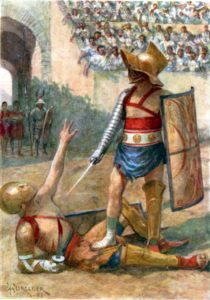Gladiators
Types of Gladiators
There were a range of different gladiators, who were matched carefully in traditional pairings. Some were rarer than others, like the essedarius, a type of gladiator who fought from a war chariot. Others, like the Thracians, were far more common. Unfortunately we’re not always that sure how some of the gladiators fought, because some like the scissor were so rare. And the types of gladiators changed over the years; some early forms, like the Samnites, were dropped once the Roman people and the Samnites became allies.
The following inscription from near Rome and dating to 117 CE gives a record of different types of gladiators, organised into decuria, groups of ten men.
In the consulship of the Emperor Caesar Lucius Aurelius Commodus and Marcus Plautius Quintillus. The leaders of the collegium of Silvanus Aurelianus, overseers Marcus Hilarus, freedman of Augustus and Coelius Magnus the cryptarius.
Decuria I
Borysthenes,[1] veteran Thracian
Clonius, veteran hoplomachus
Callisthenes, veteran Thracian
Zosimus, veteran essedarius
Plution, veteran essedarius
Pertinax, veteran contraretiarius
Carpophorus, veteran murmillo
Crispinus, veteran murmillo
Pardus, veteran provocator
Miletus, veteran murmillo
Decuria II
Vitulus, veteran murmillo
Demosthenes, manicarius[2]
Felicianus, novice retiarius
Servandus, novice retiarius
Iuvenes, murmillio with one fight
Ripanus, novice contraretiarius
Silvanus, novice contraretiarius
Eleuther, novice Thracian
Pirata, unctor[3]
Decuria III
Barosus, novice contraretiarius
Aemilianus, contraretiarius
Ulpius Europoras
Proshodus, novice contraretiarius
Aurelius Felicianus
Aurelius Felix
Zoilus, paganus
Flavius Mariscus
Flavius Sanctus
Diodrus paganus
Decuria IV
Aprilis, paganus
Zosimus Thracian with one fight…
CIL 6.331, 6.332
This following inscription lists the members of a gladiatorial familia and was found in Venusia, a town in Southern Italy. Some of these gladiators, like the scissor, were incredibly rare.
Oceanus, slave of Avilius, novice.
Sagittarius: Dorus, slave of Pisius, 6 wins, 4 crowns
Veles: Mycter, slave of Ofilius, 2 wins
Hoplomachus: Phaeder, slave of Avilius, novice.
Thracians: Donatus, slave of Nerius, 12 wins, 8 crowns; Hilario, Arrius’ slave, 7 wins, 5 crowns; Aquilia, slave of Pisius, 12 wins, 6 crowns; Quartio, slave of Munilius, 1 win; Gaius Perpenius, novice
Murmillones: Amicus, slave of Munilius, 1 win; Quintus Fabius, 5 wins, 3 crowns; Eleuther, slave of Munilius, 1 win; Gaius Memmius, 3 wins, 2 crowns; Anteros, slave of Munilius, 2 wins; Atlans, slave of Donius, 4 wins, 1 crown;
Essedarius: Inclutus, Arrius’ slave, 5 wins, 2 crowns
Samnite: Strabo, slave of Donius, 3 wins, 2 crowns
Retiarius: Gaius Clodius, 2 wins
Scissor: Marius Caecilius, novice
Gallus:[4] Quintus Granius, novice
CIL 9.466 = ILS 5083a

In his Dream Book, an ancient guide on how to interpret dreams, Artemidorus gives a little information of the fighting style of the Thracian.
I have often observed that this dream [of fighting gladiators] indicates that a man will marry a woman whose character matches the weapons that he dreams he is using or the type of opponent he is fighting…For example, if a man fights a Thracian he will marry a rich, cunning wife, fond of being first. She will be rich because the Thracian’s body is covered all over by his armour; cunning because his sword is curved, and fond of being first because the Thracian advances when he fights.
Artemidorus, Dream Book 2.32
Other types of gladiators: andabata and laquearius.
Exercise
How many different types of gladiators did an average gladiatorial school have?. What does that mean about how many an audience would have expected to see at a show?
Bibliography and Further Reading
- Coulston, J. C. N. 1998. Gladiators and soldiers: Personnel and equipment in ludus and castra. Journal of Roman Military Equipment Studies 9:1–17
- Carter, Michael. 2008. (Un)dressed to kill: Viewing the retiarius. In Roman dress and the fabrics of Roman culture. Edited by Jonathan Edmondson and Alison Keith, 113–135. Toronto: Univ. of Toronto Press
- Kanz, Fabian, and Karl Grossschmidt. 2006. Head injuries of Roman gladiators. Forensic Science International 160:207–216
Media Attributions
- Illustration_end_of_a_combat_of_gladiators © Photo by Amédée Forestier is licensed under a Public Domain license
- Detail of Gladiator mosaic © Photo by Carole Raddato
- The single name indicates that the gladiator was a slave. ↵
- A type of gladiator who tried to manacle his opponent. ↵
- An unctor was someone who oiled up or provided oil for the gladiators. ↵
- A type of gladiator based on Gallic soldiers. It did not survive the early imperial period, being replaced by the murmillo. ↵
A gladiator who fought from a British style war chariot. This type may have been introduced by Julius Caesar after his ‘conquest’ of the island.
A type of gladiator who fought with a small shield (called a parmula) and a curved, short sword.
A very rare type of gladiator about which we know little.
One of the original types of gladiators, named after an Italian tribe that was once an enemy of the Romans; when the Romans became friendly with them, this type vanished, to be replaced by the Thracian.
This is a stub and will be updated soon.
A “shield-fighter”; the word is originally Greek. This gladiator carried a short round shield, a spear, and a dagger, which was adapted from Greek infantry equipment. He had a helmet and greaves as well.
A heavily armed gladiator whose helmet had a decorative murmillo, a type of salt-water fish, on it. He had a large oblong shield behind which he crouched and used a gladius, a short thrusting sword.
A net fighter, perhaps the most iconic gladiator type of all. His weapon was a trident and he tried to trap opponents in his net. He had very little protective equipment and wore no helmet.
A rare type of gladiator who fought with a bow and arrows. If you think this is not a terrifying type, then you’ve never heard of Katniss Everdeen.
A rare type of gladiator who fought blindfolded. On horseback. No one really knows how that worked, but one hopes the horses were well-trained.
A type of gladiator who tried to snare his opponent with a lasso.


